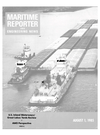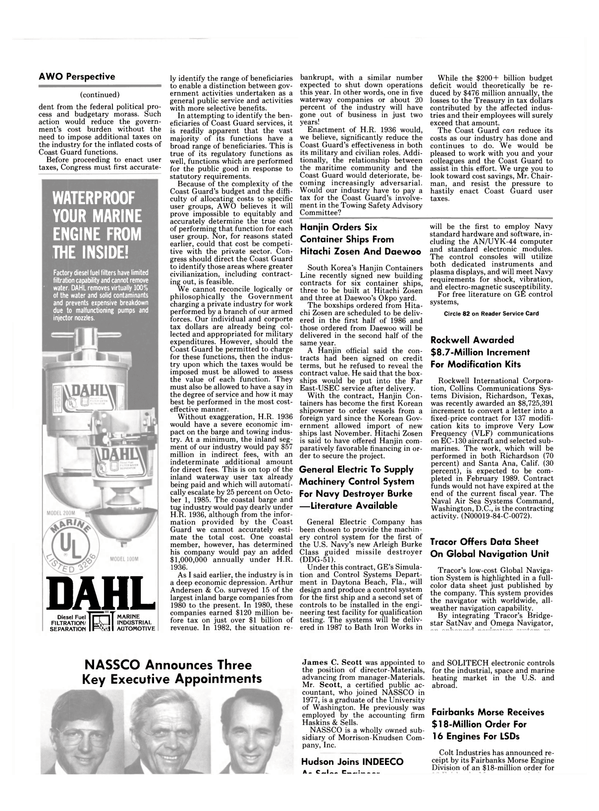
Unique Controllers Operate Cargo Area HVAC System On New MPS
The 2nd Lt. John P. Bobo, the first of five Maritime Prepositioning Ships (MPS) designed and built by General Dynamics' Quincy, Mass., shipyard for charter to the Military Sealift Command, will serve as floating warehouses for vehicles, fuels, ammunition, food, medical supplies, and other temperaturesensitive materials through areas that will range from intense heat and humidity to extremes of Arctic cold. Therefore, their cargo area heating, ventilating, and and air conditioning (HVAC) systems have some very special control requirements.
To meet these requirements, General Dynamics engineers have designed a complex system utilizing a single main vent system (MVS) running the length of the ship. Each of the individual cargo areas is served by the MVS, but each has its own independently operated fans, heaters, humidifiers, and air conditioning units. And to prevent overloading of the ship's generating system, all of these components are interconnected through a single control system.
The system is based upon a programmable controller with six remote I/O units, a specially designed alarm and control panel (ACP), and six Telemecanique Inc. programmable motor control centers (PMCC). "We chose a programmable controller because of the logic requirements," says Warren Freeman, manager of electrical engineering at Quincy, "and because of its ease of use at sea. We also had some very tight space restrictions to consider." The controller is a Modicon 584 from Gould, Inc. It serves to continuously monitor the total system condition, and drives the seven I/O channels—one local for the ACP, the others in the cargo areas. The I/Os are connected to the controller via coaxial cable. There are two coaxial paths between each I/O and the controller—the redundancy being a safety and damage control consideration.
This distributed I/O design also permits maintenance shutdowns on individual subsystems without disturbing the operation of the other components in the system.
The HVAC system components on each of the six remote I/O channels are controlled through the PMCCs. These contain the contactors and starters for each of the components. They also contain manual control pushbuttons for each of the MVS fans. These are used to control the fans when they are not being operated in a group mode from the ACP. All MVS fans are two-speed units, and all speed changes are preprogrammed to go through a "stop" condition. In addition, if CO, is detected in the hold area, indicating the presence of firefighting vapors, all supply and exhaust fans in that area are turned off automatically.
The PMCCs'also start all fans, motors, and heaters sequentially in steps of less than 100 hp or 60 kw.
They also serve to interlock many of the other components. For example, the vehicle starting rectifier contactors are interlocked with the motor gas fuel and de-fuel pumps. Any "emergency stop" condition in a vehicle cargo hold will also turn off these pumps. Even cooling-coil solenoids are interlocked with their control contacts and recirculation fans.
In its normal mode, the complete system functions automatically.
However, it may also be operated in a manual mode in which all components can be stopped or started individually for maintenance purposes.
At the time of purchase of this system, the ACP and the PMCCs were furnished by the Industrial Control Division of Gould, Inc.
Since that time, however, that division has been sold to Telemecanique Inc., a major supplier of programmable controllers, motor control centers, switches, relays, pilot devices, sensing devices, and power distribution systems.
For additional information on the company and its products, Circle 16 on Reader Service Card
Read Unique Controllers Operate Cargo Area HVAC System On New MPS in Pdf, Flash or Html5 edition of August 1985 Maritime Reporter
Other stories from August 1985 issue
Content
- Houston Ship Repair Reactivates 40-Year-Old Hattiesburg Victory page: 5
- Cybernet Introduces Multi-Scan, High-Tech VHF-FM Radiotelephone page: 5
- Navy Announces Homeport Sites In Gulf Coast Area page: 5
- Hunt Associates And Gladding-Hearn Collaborate On Pilot Boat Design page: 6
- Johnson-Duramax Stuffing Boxes Make Packing Changes Easier page: 6
- Versatile FPSO Manifold System Eliminates Fluid Swivels page: 7
- Consolidation Of Chevron And Gulf Fleets Announced page: 7
- Murdock Engineering Introduces New Tension System Design page: 7
- Joseph Cuneo Elected Board Chairman & CEO Of J.J. Henry Co., Inc. page: 8
- Jeffboat Delivers River Towboat M/V Cletus To Luhr Brothers page: 8
- Reagan Nominates Navy's First Space And Warfare Systems Commander page: 8
- Total Transportation Systems Acquires Kenmark page: 8
- New Navigation System From Odin Electronics page: 8
- Free Brochure On Piston And Plunger Pumps From Cat Pumps page: 9
- Aluminum Boats, Inc. Delivers 'Abeer Nine' To Saudi Arabia page: 10
- Unique Controllers Operate Cargo Area HVAC System On New MPS page: 10
- Pfeiffer And Military Sealift Command To Receive AOTOS Awards page: 11
- Great Lakes International To Spend Over $30 Million On Dredge —Bids To Be Taken On Another page: 11
- Halter Delivers Rocket Booster Recovery Vessel 'Independence' page: 11
- Australia Plans To Build Diesel-Electric Submarines Of European Design page: 11
- Arnessen Offers Full-Color Brochure On Atlas-Danmark Freshwater Generators page: 11
- COAST GUARD USER TAXES: UNTIMELY AND UNWISE page: 12
- 'FUEL SAV-R —New Fuel Monitor From National Control Systems page: 12
- Wartsila Vasa 32 Engine In Demand For New Generation Drilling Rigs page: 12
- Wartsila-Normed Joint Venture To Manufacture Diesels In France page: 13
- General Electric To Supply Machinery Control System For Navy Destroyer Burke page: 14
- Racai Wins Contract From State Of Louisiana For Marine Simulator page: 14
- Unitor Announces Two N e w Services For Marine Refrigeration page: 15
- Pettit Paint Expands Antifoulings Market Base page: 15
- NASSCO Announces Three Key Executive Appointments page: 16
- OFFSHORE EUROPE 85 Exhibition & Conference page: 16
- INLAND WATERWAYS/ GREAT LAKES YARDS Review page: 18
- Omnipure Opens New Headquarters And Plant In Sugar Land, Texas page: 26
- Siess Will Chair NOIA's Pro-Leasing Task Force page: 26
- W i l l i am M. Lechler Joins Sumitomo Machinery Corp. page: 28
- Anderson Named President Of Raytheon Marine European Operations page: 28
- NMEA Annual Meeting To Be Held October 13-15 In Seattle page: 29
- Manitowoc Announces Six New Personnel Additions At Manitex Subsidiary page: 29
- Great Lakes Firm Offers Extensive Inventory Of Marine Equipment Spare Parts page: 30
- Cruise Yacht Ponce De Leon Now Being Built At Marine Fabricators For Florida Gulf Coast Corporation page: 30
- NICOR And Sonat Subsea Form Gulf Joint Venture page: 32
- Hydraulic Pump Offers Up To 21,300 PSI Pressure page: 32
- McDermott Elects B a r r ow To Board Of Directors page: 34
- D i l l i n g h am M a r i t i m e Forms N e w U n i t — V a n Dawark Named Executive VP page: 34
- Heale Named President Of Oceanroutes To Succeed Snideman page: 35
- N e w Positions For Three Managers Announced By Zapata Gulf Marine page: 35
- Hudson Joins North American Towing As Special Representative page: 36
- Oil Monitor/Separator Allows Operators To Meet MARPOL 7 3 / 7 8 Ruling page: 36
- Free Brochure On Newco Marine Valves Offered By Newman's page: 37
- Bailey Technical Center Opens In Beijing, China page: 37
- Wager Announces New Diesel Exhaust Meter page: 37
- Free 32-Page Full-Color Brochure Details Hagglunds Cargo Cranes page: 37
- Luxury Cruise Liner 'Holiday' Delivered By Aalborg Shipyard page: 38
- Unaflex Introduces 'Supreme' Tapered Expansion Joints page: 38
- Carrier Transicold Donates Air Conditioning Units To Cousteau Vessel page: 38
- Management Promotions For Rigdon, Dowie & Cox Announced By Zapata page: 39
- Energy-Saving Tanker 'Manitou' Delivered By Lindenau Shipyard page: 40
- Alfa-Laval Introduces Nirex Distiller For Smaller Vessels page: 40
- Tidewater Adopts $40-Million Capital Expenditure Budget For Fiscal 1986 page: 41
- WABCO Offers Free Brochure On HelmMaster® Control Systems page: 44
- John Crane Bulletin Describes New Compact Package Seals page: 44
- Hayward Expands Duplex Basket Strainer Line page: 44
- Mark Controls Expands SD Butterfly Control Valve Line page: 45
- Shipbuilding Standards Groups Seeking Participants page: 45
- Johnson-Duramax Bearings Offer Performance Advantages page: 51
- BMEP Balancer Used To Increase Fuel Efficiency In Diesels page: 54
- System For Renovating Floors Described In N e w Brochure page: 54


